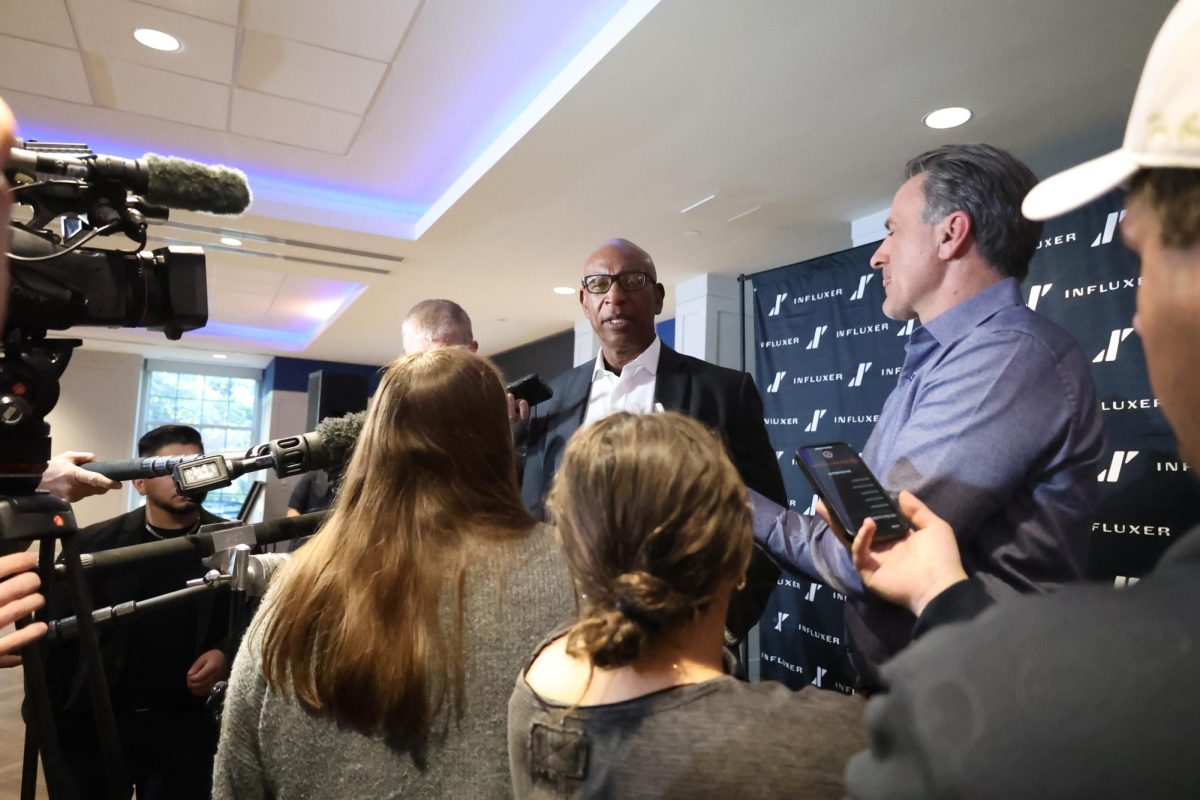
After the halftime show of SMU’s Homecoming game, scores of students exited Ford Stadium, leaving the last twenty rows almost completely deserted. SMU’s comparatively high athletic deficit is partly due to low attendance at football games, according to the faculty chair of SMU’s athletic policies committee. (Sidney Hollingsworth/The Daily Campus)
Dozens of SMU students, faculty members and staffers spent the first Thursday of the 2012 spring semester celebrating a new era at the university – SMU’s invitation to join the Big East Conference.
The Hughes-Trigg Student Center was filled with excitement as President R. Gerald Turner announced that joining the Big East meant SMU had finally made it back to the national stage of college athletics.
What Turner didn’t say is that while SMU is enjoying greater success on the field and landing high-profile coaches like Larry Brown and June Jones, its athletic department is piling up substantial losses.
Over the past seven years, its losses have topped $113 million. The deficit is equal to almost half of all tuition and fees paid by students in the 2011 to 2012 school year.
The losses shocked students.
“After hearing this, I find it ridiculous and humiliating,” Mark Butler, a senior finance major, said. “With all of the smart individuals involved at this university, you would think that we could find ways to not burn through cash over such a secondary priority. I think any student should be outraged at this fact.”
The athletic department’s annual deficit rose dramatically after Turner selected Steve Orsini as athletic director in 2006.
During the three years before Orsini arrived, the athletic department lost an average of $12.9 million a year.
In Orsini’s first four years, the annual losses jumped to an average of $18.6 million – an increase of 44 percent.
Orsini acknowledged that the data was accurate, saying that SMU knows about the operating deficit and approves it as a part of the university’s budget.
The reality that the SMU Athletic Department loses money hardly makes it unique among U.S. universities.
What is startling – and unknown to most students – is the size of those losses.
A 2010 NCAA report examined the athletic department budgets of SMU and the other 119 Football Bowl Subdivision (FBS) schools.
Ninety-eight lost money. Between 2007 and 2010, the median annual deficit for these colleges was about $9.6 million.
During this same period, the SMU athletic department lost $18.6 million annually – nearly twice the median deficit of the other schools.
The total median deficit for the 98 FBS schools was $38.47 million from 2007 to 2010. The total deficit for SMU during that time was $74.42 million.
According to Dan Fulks, a Transylvania University accounting professor and research consultant for the NCAA, only about 15 of the 98 net loss schools lost more than SMU.
Dan Orlovsky, the faculty chair of SMU’s athletic policies committee, says SMU’s comparatively high losses are a result of little television money, low attendance at football games, high expenditures in recent years and travel expenses.
Orlovsky calls SMU athletics a business.
“It costs money to do business, that’s the bottom line. You can’t make money if you don’t put money in,” he said.
SMU officials deny that the athletic department operates under a deficit.
Instead, they consider it a budgeted university subsidy – an investment that brings national exposure.
According to a prepared statement issued through SMU’s Office of Public Affairs, Chris Regis, vice president for business and finance said, “Athletics does not operate with a deficit, rather is supported at an acceptable level from institutional resources as they do bring significant value to the university.”
Since 2006, Turner has served as the co-chair of the Knight Commission on Intercollegiate Athletics, a watchdog group that presses for greater fiscal responsibility and increased transparency by college athletic departments all over the country.
In April 2010, Turner told USA Today, “It’s important that these issues about athletic expenditures be brought out to where there is some public support for more rational approaches to this.”
Turner’s message apparently has not registered with the SMU Athletic Department. Kristopher Lowe, the associate athletics director for business at SMU, refused to provide spending figures to The Daily Campus.
“Based on the purpose of your request, I am not able to provide this information at this time,” he said in an emailed response.
While the athletic department wouldn’t provide budget documents, Brad Sutton, the associate athletic director over public relations and marketing, did say in an emailed statement that “The 2011 fiscal year was SMU Athletics’ best fundraising year to date, as the Mustangs added more than $6.5 million to the coffers in annual gifts, while also setting a record in royalties received.”
Still, the athletic department’s lack of transparency upsets some students.
“Students should definitely be able to see where the money is spent,” Ricky Townsend, a senior, said.
Townsend isn’t alone. Butler feels the same way.
“We need to understand where every single dollar is being spent,” he said. “Especially after the scandals that have plagued this campus for decades surrounding monetary infractions.”
In January 2011 SMU extended Orsini’s contract, crediting him with what it called “increased efficiencies at the university.”
But budget documents show spending has accelerated since Orsini started calling the shots.
According to records, expenses in the athletic department amounted to $26.6 million in 2007, then increased to $32.1 million in 2008, $35.3 million in 2009 and $35.8 million in 2010, the most recent year that actual figures are available.
Orsini explained the rise in expenses as a result of increased scholarships for student athletes.
However, the figures show annual grants-in-aid (scholarships) in the Orsini era have increased by $3.26 million, or 41 percent. Excluding scholarships, annual expenses post-Orsini have increased by $5.91 million, or 35 percent.
The athletic department’s definition of increased efficiencies is unique because it doesn’t include scholarships as an expense.
In 2010 Jay Weiner, a sports journalist and consultant of the Knight Commission, told The Daily Campus scholarships should be included in calculating the bottom line for athletic programs.
“Grants-in-aid are an expense, indeed,” Weiner said. “Across the Football Bowl Subdivision they account for 16 percent of athletic departments’ costs.”
At SMU in
2010, grants-in-aid accounted for 36.3 percent of athletic expenses, reflecting the Hilltop’s higher tuition in comparison to most FBS schools.
According to Sutton, athletics has decreased the university’s level of support of operations by 44 percent since 2007.
The budget shows that, excluding scholarships, the annual deficit has dropped from $7.9 million in 2007 to about $4.5 million in 2011 – a decrease of 43 percent.
But the overall expenses of the athletic department, including scholarships, increased 33.8 percent from $26.2 million in 2007 to about $35.6 million in 2011.
And Orsini says it’s worth it.
In a Feb. 15 speech to SMU Faculty Club members on the state of college athletics, Orsini focused on the additional benefits athletics brings to the university, such as increased national exposure, despite adding expenses to the budget.
Richard Alm, a member of the SMU Cox faculty, attended the event and believes that joining the Big East is a big step up for SMU.
But, Alm also worries about whether SMU’s teams are ready to play at this higher level of competition.
“Losing will be a setback for the athletic department’s top priority – raising attendance,” Alm said in an email interview.
Butler said that taking some of his tuition money for athletics is to be expected.
But he says he pays for education, not a “mediocre sports club.”
Students said they are concerned that their tuition money helps make up for the deficit.
Townsend disagrees with the use of tuition to help cover the athletic department’s losses.
“I think it’s insane that our money continues to go into a black hole of mismanagement that we don’t even have access to see the specifics of,” he said.
Regis said that tuition is just one of numerous revenue sources that support the university, including annual giving from donors, interest income and endowment income.
Orsini has also created a group of wealthy boosters called the “Circle of Champions” to support the athletic program.
Orlovsky recognizes the economic challenges of college athletics as a whole.
“It’s like what I teach, which is history of the the Soviet Union – we want reform, but nothing seems to work until the whole thing collapses, and maybe that’s what’ll happen with this.
But, as long as you have the media feeding it and the big money, it’s tough,” he said.
He is hopeful that joining the Big East will be a step in the right direction for the university.
SMU recently made headlines with its decision to hire Larry Brown as the head coach of the men’s basketball team.
But, Brown and his assistants don’t come cheap.
Terms of Brown’s contract have not been publicly disclosed, but when asked about it at his press conference, Brown told The Associated Press, “I’ve always been overpaid and this is no exception.”










